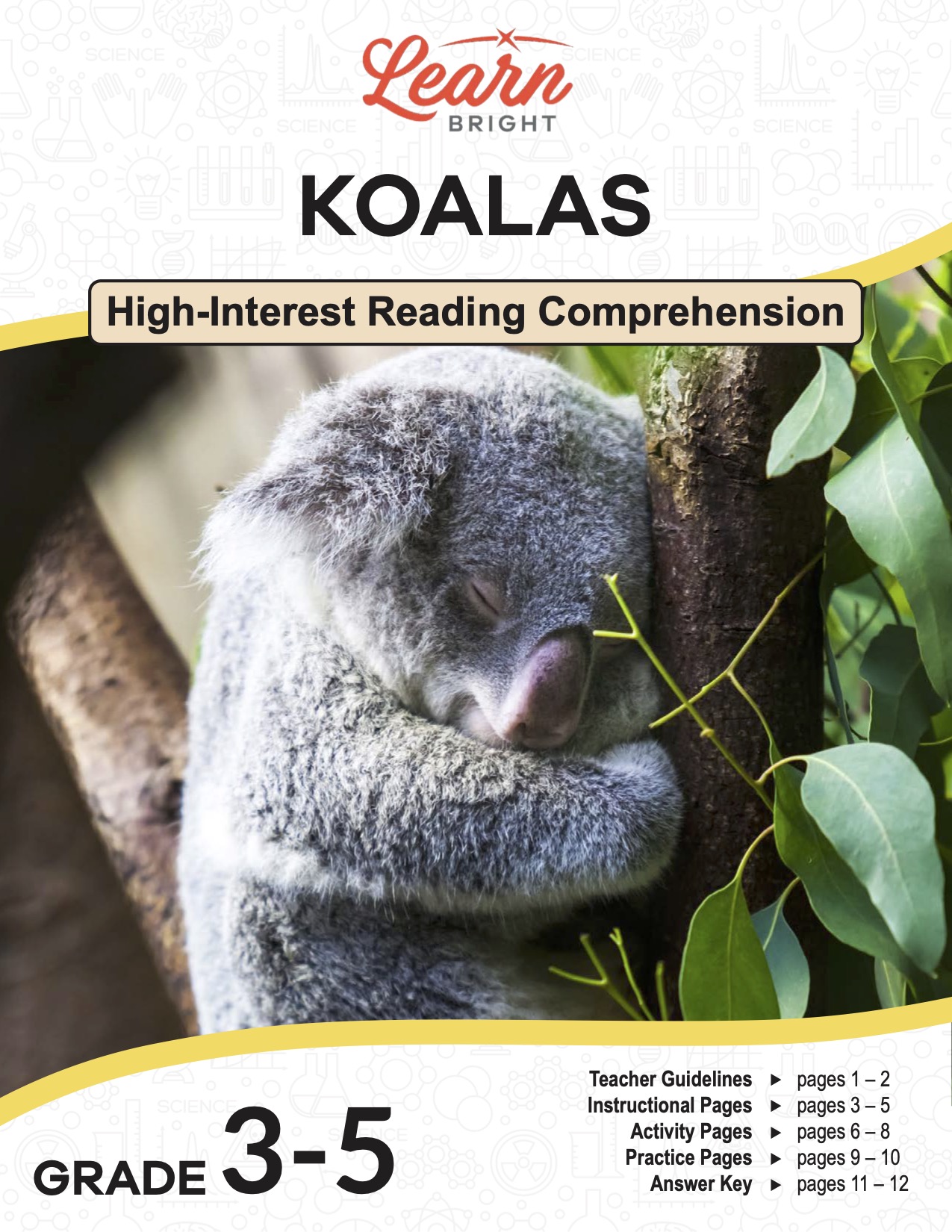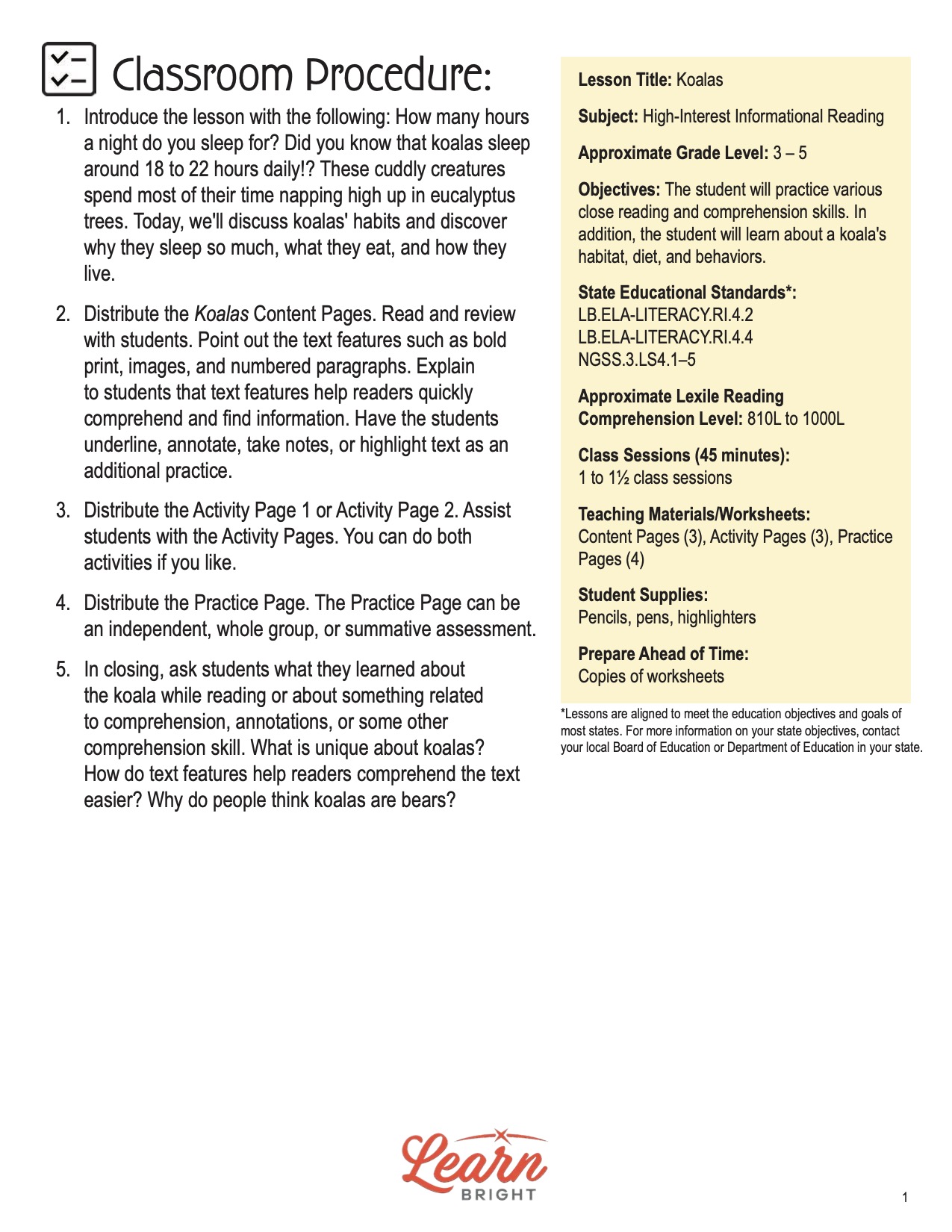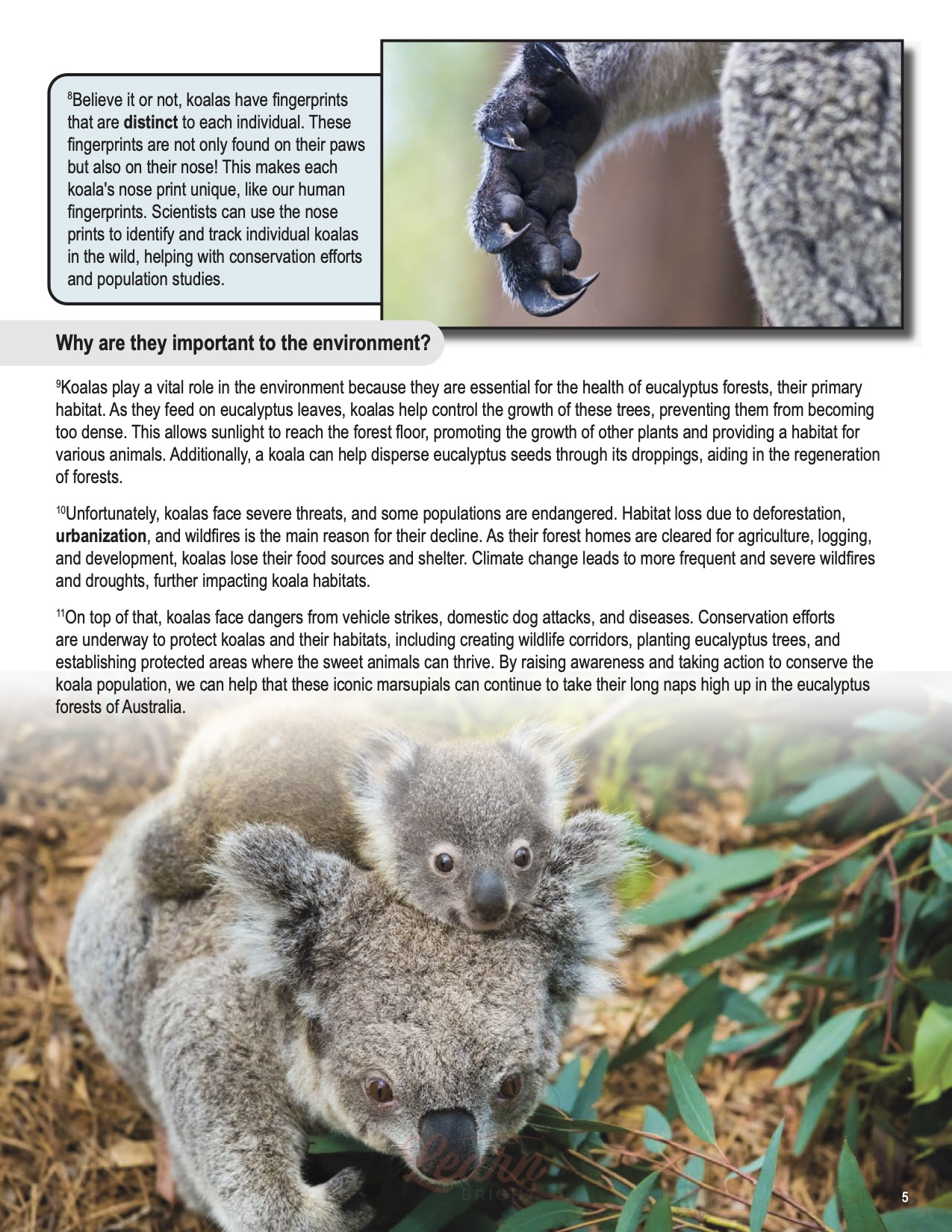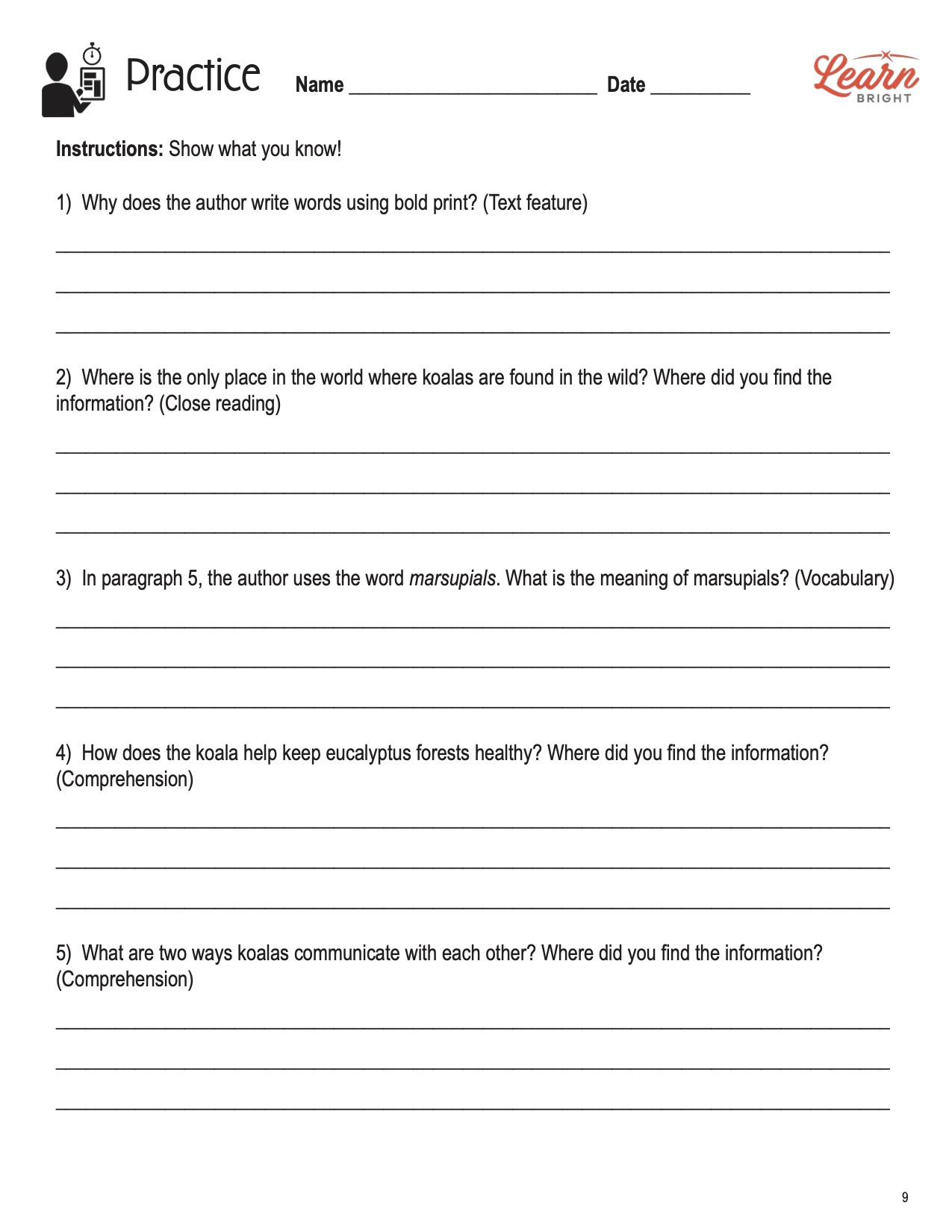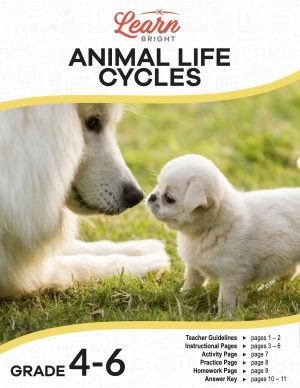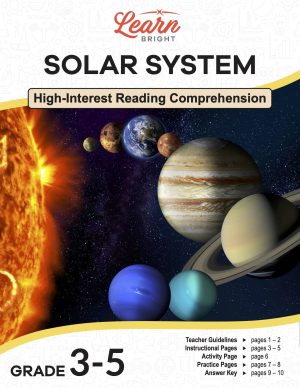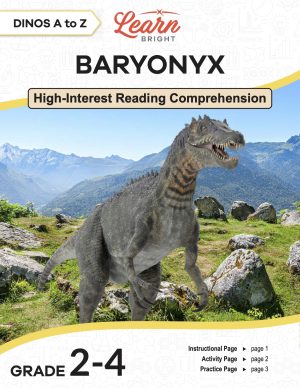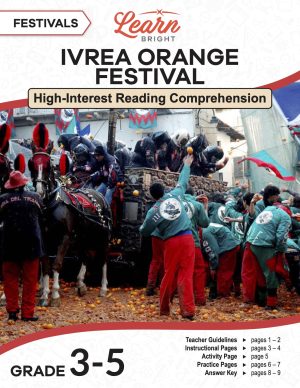Description
What our Koalas lesson plan includes
Lesson Objectives and Overview: Koalas is a high-interest reading comprehension lesson plan. As such, students will practice various close reading and comprehension skills. In addition, they will learn about the koala’s habitat, diet, and behaviors. This lesson is for students in 3rd grade, 4th grade, and 5th grade.
Classroom Procedure
Every lesson plan provides you with a classroom procedure page that outlines a step-by-step guide to follow. You do not have to follow the guide exactly. The guide helps you organize the lesson and details when to hand out worksheets. It also lists information in the yellow box that you might find useful. You will find the lesson objectives, state standards, and number of class sessions the lesson should take to complete in this area. In addition, it describes the supplies you will need as well as what and how you need to prepare beforehand.
Teacher Notes
The paragraph on this page gives you a little more information on the lesson overall and describes what you may want to focus your teaching on. It explains that you can teach this lesson in a whole-class setting or as an independent, small-group activity. The blank lines are available for you to write out any thoughts or ideas you have as you prepare.
KOALAS LESSON PLAN CONTENT PAGES
What Is a Koala?
The Koalas lesson plan contains three content pages. It begins by providing a box of background information about this animal. Koalas are cute and cuddly little animals. They have soft, fluffy fur in colors that range from gray to brown, helping them blend in with the trees where they live. They have big round ears and a large, black nose to sniff out their favorite food: eucalyptus leaves. Their sharp claws and padded feet make them excellent climbers, too, allowing them to grip tree branches securely. Koalas also have strong jaws and teeth that are specially adapted for chewing the tough eucalyptus leaves, which are their primary food source.
You will only find koalas in the wilds of Australia, their native land. Koalas live in eucalyptus forests along the eastern and southern coasts. These forests provide them with plenty of food and shelter. Koalas are usually solitary animals, meaning they prefer to live alone rather than in groups. Each koala has its own territory that it marks with its scent to keep other koalas away. However, they may occasionally share space with other koalas, especially during breeding season. Despite having a territory, they are not territorial and can peacefully coexist with other koalas in the same area.
When caring for their young, koala mothers are extremely devoted. A baby koala, called a joey, is born after a short gestation period of about 35 days. At birth, the joey is tiny and undeveloped. It is only the size of a jellybean! It crawls into its mother’s pouch, where it drinks specially formulated milk and continues to develop for several months. As the joey grows, it eventually ventures out of the pouch. The young koala stays close to its mother for protection and guidance until it’s ready to venture on its own.
Diet of a Koala
Koalas are herbivores, which means they only eat plants. And as you remember, their favorite food is eucalyptus leaves. Eucalyptus leaves are tough and not very nutritious, but koalas have particular adaptations to help them digest this food. They spend most of their time eating eucalyptus leaves and resting in trees. Naturally, they are excellent climbers. They have two thumbs on each front paw to help them grip branches and climb trees more efficiently. Their sharp claws and padded feet help them grip tree branches securely.
Interesting Facts
Many people often call koalas “koala bears,” but koalas are not bears. They certainly have some bear-like characteristics, though, which is probably why people get confused. Koalas are marsupials, which means they carry their young in a pouch. As such, they are related to other marsupials, like kangaroos, wallabies, and even possums!
One remarkable fact about koalas is that they have a unique adaptation in their digestive system to help them eat those tasty eucalyptus leaves. These leaves contain toxins. Koalas have stomach bacteria that help break down the toxins and extract leaf nutrients. In addition, they have a long digestive tract that allows them to digest their fibrous diet efficiently. This unique digestive system is one of the reasons koalas can survive on a diet of eucalyptus leaves alone.
Koalas have a unique way of communicating. They make various sounds—including grunts, barks, and even bellows—to communicate different things. Bellows can be heard from up to a mile away! This is important because they are solitary animals and need a way to interact over long distances in dense eucalyptus forests. Koalas also use their sense of smell to mark their territory and identify other koalas. They have scent glands on their chests, which they rub against trees to leave their scent behind. This is how they establish their territory and communicate with other koalas in the area.
Believe it or not, koalas have fingerprints that are distinct to each individual. These fingerprints are not only found on their paws but also on their nose! This makes each koala’s nose print unique, like our human fingerprints. Scientists can use the nose prints to identify and track individual koalas in the wild, helping with conservation efforts and population studies.
Why Koalas Are Important to the Environment
Koalas play a vital role in the environment because they are essential for the health of eucalyptus forests, their primary habitat. As they feed on eucalyptus leaves, koalas help control the growth of these trees, preventing them from becoming too dense. This allows sunlight to reach the forest floor, promoting the growth of other plants and providing a habitat for various animals. Additionally, a koala can help disperse eucalyptus seeds through its droppings, aiding in the regeneration of forests.
Unfortunately, koalas face severe threats, and some populations are endangered. Habitat loss due to deforestation, urbanization, and wildfires is the main reason for their decline. As their forest homes are cleared for agriculture, logging, and development, koalas lose their food sources and shelter. Climate change leads to more frequent and severe wildfires and droughts, further impacting koala habitats.
On top of that, koalas face dangers from vehicle strikes, domestic dog attacks, and diseases. Conservation efforts
are underway to protect koalas and their habitats, including creating wildlife corridors, planting eucalyptus trees, and establishing protected areas where the sweet animals can thrive. By raising awareness and taking action to conserve the koala population, we can help that these iconic marsupials can continue to take their long naps high up in the eucalyptus forests of Australia.
KOALAS LESSON PLAN WORKSHEETS
The Koalas lesson plan includes three worksheets: two activity worksheets and a practice worksheet. Each one will help students solidify their grasp of the material they learned throughout the lesson. You can refer to the classroom procedure guidelines to know when to hand out each worksheet.
The Daily Zoo Activity
For the first activity, students will pretend they write as a reporter for The Daily Zoo and compose an article or blog about koalas and how they are NOT bears. They must research the animals first and ensure they include the number of paragraphs listed on the worksheet. Then they will write the article and include pictures or drawings with captions. They can use the template provided or come up with their own format.
Compare and Contrast Activity Worksheet
The second activity requires students to compare and contrast a koala and a bear. They will first list the differences between the two animals. Then they will write how they are similar in the box at the bottom of the page.
KOALAS PRACTICE WORKSHEET
The practice worksheet requires students to answer a series of 10 questions. These questions all relate to the content pages, so students will need to refer to them often for the answers. In addition, each question provides which reading tool the question corresponds to, such as text feature, vocabulary, or comprehension.
Worksheet Answer Keys
At the end of the lesson plan document is an answer key for the practice worksheet. The correct answers are all in red to make it easier for you to compare them with students’ responses. If you choose to administer the lesson pages to your students via PDF, you will need to save a new file that omits these pages. Otherwise, you can simply print out the applicable pages and keep these as reference for yourself when grading assignments.

